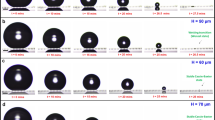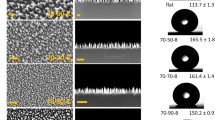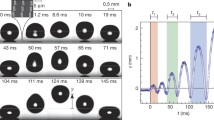Abstract
The paper reports on the wetting characterization of two surfaces presenting reentrant shapes at micro- and nanoscale using low surface tension liquids (down to 28 mN/m). On the one hand, mushroom-like microstructures are fabricated by molding poly(dimethylsiloxane) (PDMS) onto a patterned sacrificial photoresist bilayer. On the other hand, zinc oxide nanostructures (ZnO NS) are synthesized by easy and fast chemical bath deposition technique. The PDMS and ZnO NS surfaces are then chemically modified with 1H,1H,2H,2H-perfluorodecyltrichlorosilane in vapor phase. Both PDMS and ZnO NS surfaces exhibit a large apparent contact angle (>150°) and contact angle hysteresis varying from 50° to a quasi-null value. This large discrepancy can be ascribed to the length scale and topography of the structures, promoting either a vertical imbibition or a lateral spreading within the roughness.







Similar content being viewed by others
References
Barthlott W, Neinhuis C (1997) Purity of the sacred lotus, or escape from contamination in biological surfaces. Planta 202:1–8
Cassie ABD, Baxter S (1944) Wettability of porous surfaces. Trans Faraday Soc 40:546
Shirtcliffe NJ, McHale G, Atherton S, Newton MI (2010) An introduction to superhydrophobicity. Adv Colloid Interface Sci 161:124–138
Nosonovsky M, Bhushan B (2009) Superhydrophobic surfaces and emerging applications: non-adhesion, energy, green engineering. Curr Opin Colloid Interface Sci 14:270–280
Marmur A (2006) Underwater superhydrophobicity: theoretical feasibility. Langmuir 22:1400–1402
Koch K, Bhushan B, Barthlott W (2009) Multifunctional surface structures of plants: an inspiration for biomimetics. Prog Mater Sci 54:137–178
Otten A, Herminghaus S (2004) How plants keep dry: a physicist’s point of view. Langmuir 20:2405–2408
Krumpfer J, McCarthy T (2010) Contact angle hysteresis: a different view and a trivial recipe for low hysteresis hydrophobic surfaces. Faraday Discuss 146:103–111
Reyssat M, Richard D, Clanet C, Quere D (2010) Dynamical superhydrophobicity. Faraday Discuss 146:19–33
Lapierre F, Brunet P, Coffinier Y, Thomy V, Blossey R, Boukherroub R (2010) Electrowetting and droplet impalement experiments on superhydrophobic multiscale structures. Faraday Discuss 146:125–139
Kumari N, Garimella SV (2011) Electrowetting-induced dewetting transitions on superhydrophobic surfaces. Langmuir 27:10342–10346
Boreyko JB, Baker CH, Poley CR, Chen CH (2011) Wetting and dewetting transitions on hierarchical superhydrophobic surfaces. Langmuir 27:7502–7509
Zhang J, Han Y (2009) "Dual-parallel-channel" shape-gradient surfaces: toward oriented and reversible movement of water droplets. Langmuir 25:14195–14199
Lapierre F, Piret G, Drobecq H, Melnyk O, Coffinier Y, Thomy V, Boukherroub R (2011) High sensitive matrix-free mass spectrometry analysis of peptides using silicon nanowires-based digital microfluidic device. Lab Chip 11:1620–1628
Lee C, Kim CJ (2011) Underwater restoration and retention of gases on superhydrophobic surfaces for drag reduction. Phys Rev Lett 106:014502
Whyman G, Bormashenko E (2011) How to make the Cassie wetting state stable? Langmuir 27:8171–8176
Tuteja A, Choi W, Ma ML, Mabry JM, Mazzella SA, Rutledge GC, McKinley GH, Cohen RE (2007) Designing superoleophobic surfaces. Science 318:1618–1622
Bormashenko E (2009) A variational approach to wetting of composite surfaces: is wetting of composite surfaces a one-dimensional or two-dimensional phenomenon? Langmuir 25:10451–10454
Im M, Im H, Lee JH, Yoon JB, Choi YK (2010) A robust superhydrophobic and superoleophobic surface with inverse-trapezoidal microstructures on a large transparent flexible substrate. Soft Matter 6:1401–1404
Wang DA, Wang XL, Liu XJE, Zhou F (2010) Engineering a titanium surface with controllable oleophobicity and switchable oil adhesion. J Phys Chem C 114:9938–9944
Cao LL, Gao D (2010) Transparent superhydrophobic and highly oleophobic coatings. Faraday Discuss 146:57–65
Aulin C, Yun SH, Wagberg L, Lindstrom T (2009) Design of highly oleophobic cellulose surfaces from structured silicon templates. ACS Appl Mater Interf 1:2443–2452
Nguyen TPN, Brunet P, Coffinier Y, Boukherroub R (2010) Quantitative testing of robustness on superomniphobic surfaces by drop impact. Langmuir 26:18369–18373
Dufour R, Harnois M, Coffinier Y, Thomy V, Boukherroub R, Senez V (2010) Engineering sticky superomniphobic surfaces on transparent and flexible PDMS substrate. Langmuir 26:17242–17247
Perry G, Coffinier Y, Thomy V, Boukherroub R (2012) Sliding droplets on superomniphobic zinc oxide nanostructures. Langmuir 28:389–395
Kokotov M, Hodes G (2009) Reliable chemical bath deposition of ZnO films with controllable morphology from ethanolamine-based solutions using KMnO4 substrate activation. J Mater Chem 19:3847–3854
Patankar NA (2010) Hysteresis with regard to Cassie and Wenzel states on superhydrophobic surfaces. Langmuir 26:7498–7503
Srinivasan S, McKinley GH, Cohen RE (2011) Assessing the accuracy of contact angle measurements for sessile drops on liquid-repellent surfaces. Langmuir 27:13582–13589
Dufour R, Harnois M, Thomy V, Boukherroub R, Senez V (2011) Contact angle hysteresis origins: investigation on super-omniphobic surfaces. Soft Matter 7:9380–9387
Jokinen V, Sainiemi L, Franssila S (2011) Controlled lateral spreading and pinning of oil droplets based on topography and chemical patterning. Langmuir 27:7314–7320
Wenzel RN (1949) Surface roughness and contact angle. J Phys Colloid Chem 53:1466–1467
Acknowledgments
We acknowledge the European Regional Development Fund for financial support under the INTERREG IVa FW1.1.9 "PLASMOBIO" project and the European Community Seventh Framework Programme (FP7/20072013) under grant agreement no. 22724. This work was supported by Nord-Pas-de-Calais Region through the 2008-2013 CIA State Region Planning contract and by the Ministry of Defense. The authors thank Mr. Christophe Boyaval for SEM imaging.
Author information
Authors and Affiliations
Corresponding author
Additional information
Renaud Dufour and Guillaume Perry contributed equally to the article and share first co-authorship.
This article is part of the Topical Collection on Contact Angle Hysteresis
Rights and permissions
About this article
Cite this article
Dufour, R., Perry, G., Harnois, M. et al. From micro to nano reentrant structures: hysteresis on superomniphobic surfaces. Colloid Polym Sci 291, 409–415 (2013). https://doi.org/10.1007/s00396-012-2750-7
Received:
Accepted:
Published:
Issue Date:
DOI: https://doi.org/10.1007/s00396-012-2750-7




